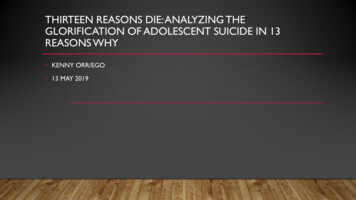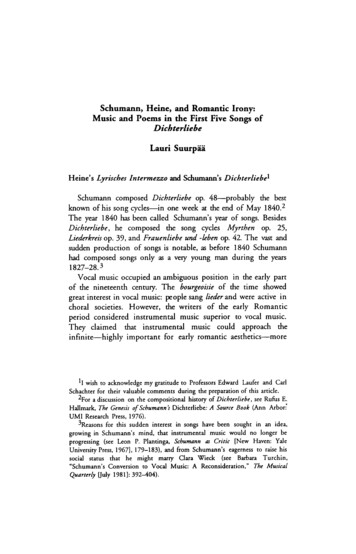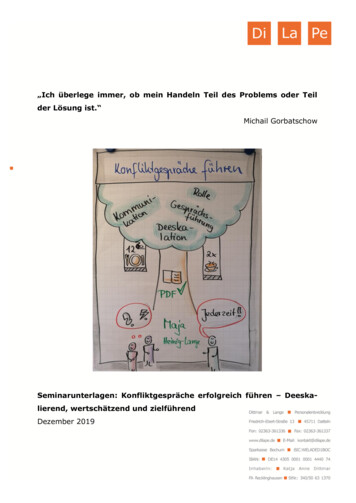
Transcription
THIRTEEN REASONS DIE: ANALYZING THEGLORIFICATION OF ADOLESCENT SUICIDE IN 13REASONS WHY KENNY ORR/EGO 13 MAY 2019
LITERATURE REVIEW Teen suicide is an under-discussed, extremely controversial issue that impacts millions ofpeople on a global level. Most of the literature on this subject focuses on prevention andnoticing signs of people who may be thinking about suicide. Another significant element of the literature is discussing statistics. A majority ofliterature on teen suicide reference that suicide is the 2nd highest cause of death amongteens, however the articles rarely talk about concrete prevention strategies. The literature on this subject does not address what measures can be taken to preventteen suicide, while some articles say that it is to be expected due to undiagnosed mentalillnesses in teens and due to societal conditions that cannot be changed.
CONTEXT FOR THE BOOK The book 13 Reasons Why was written in 2007 by Jay Asher as a way to address teen suicide, as a friendof his in high school killed herself. Since its release, it has become a required book in several schoolEnglish classes. The book is intended as a preventative measure against teen suicide by highlighting how destroyed andemotionally distraught suicide leaves people. It also attempts to show how suicide is not an answer tolife’s problems. However, the book actually romanticizes suicide by portraying Hannah’s death as more of a pettyattempt to get back at the bullies in Hannah’s lives rather than as a tragedy committed by a girl withmental illnesses. The book also focuses on how the community around Hannah was at fault and not Hannah’s decisionsor her reactions to her surroundings.
CONTEXT FOR THE SHOW The show also romanticizes suicide by depicting Hannah’s suicide as an attempt forrevenge and designed to leave the maximum emotional impact through leaving 13 tapestelling everyone involved in her suicide exactly how terrible they are. This element is present in the book, however the show develops this for more emotionalimpact due to transferring from a book to a TV show. The show also depicts several troubling images and themes. One such example isshowing Hannah killing herself by slicing her wrists with a razor blade. Other examplesinclude the rapes and making shrines to Hannah as a memorial.
PURPOSE OF PROJECT The main purpose of this project was to assess how the media portrays teen suicide. This led to a focus on the show and book 13 Reasons Why due to its recent release andthe extreme controversy and media coverage it has received over its 2 seasons onNetflix.
CATEGORIES USED Data was collected using 6 different categories. These include: Deviations from the original source material. This category was removed when analyzing the 2nd season,as it was produced entirely by Netflix since the ending of the book corresponds with the ending of the1st season. Sexual assault/harassment Psychopathology Physical violence Bullying Suicidal thoughts/ideologies
DESCRIPTION OF CATEGORIES Book deviations refers to anything that occurs in the show that either happens differently in the book ordoes not happen at all. Suicidal thoughts/actions refer to anything implying that someone is thinking of killing themselves oracting on suicidal thoughts. Sexual assault/harassment refers to instances of sexual assault/harassment. Bullying refers to instances of bullying and harassment that is outside normal high school behavior. Physical violence refers to instances of physical violence. Psychopathology refers to instances of mental illness or symptoms that could lead to a diagnosis if testedfurther.
TABLESeason 1Season 2TotalBook deviations- 119Book deviations- N/ABook deviations- 119SuicidalSuicidal thoughts/actions- 8Suicidal thoughts/actions- 23Sexual assault/harassment- 36Sexual assault/harassment- 53Bullying- 17Bullying- 31Bullying- 48Physical violence- 12Physical violence- 10Physical violence- 22Psychopathology- 36Psychopathology- 60Psychopathology- 96thoughts/actions- 15Sexualassault/harassment- 17
STATISTICS ON TEEN SUICIDE According to the 2013 Youth Risk Behavior Survey (YRBS),” 17.7% of high school studentsreported seriously considering suicide during the prior 12 months, and nearly 9% of thosestudents had attempted suicide during that same period.” (Onieal 14). Suicide prevention programs only exist in 77% of schools, which leaves certain populationsmore vulnerable. According to the CDC, teen suicide “ranks as the second leading cause of death of youthsages 10 to 24.” In 2015, 23,600 people aged 10-24 died by suicide, making it the second-leading cause of deathamong U.S. youth.
STATISTICS CONT. 68% of those who have seriously considered suicide first thought about it in high school, or even earlier. Over half of college students have thought about suicide in their lifetime, and approximately 18% haveseriously considered it. 60% knew someone who had attempted suicide (about half were close friends or relatives), and 47%knew someone who had died by suicide (34% were close friends or relatives). Nearly half of those whohave thought seriously about suicide chose not to tell anyone about their suicidal thoughts. (Becker 18). In 2015, the suicide rate for individuals aged 15 to 24 was 12.5 per 100,000. It is estimated that for everysuccessful suicide there are 25 attempts, and studies show that suicide planning has risen from 10.9% to14.6% between 2009 and 2015. (Schaffer 2).
STATISTICS SPECIFICALLY RELATING TO 13REASONS WHY The month following the premiere of 13 Reasons Why, the rate of suicide among peopleaged 10-17 increased by 28.9%. There were also 195 more youth suicides than expected in the 9 months following thepremiere of 13 Reasons Why. This highlights a principle known as the Werther Effect, AKA suicide contagion. This“occurs when a publicized suicide is correlated with an increase in suicides.” (Schaffer 1). Also according to Schaffer, “Google searches for “How to kill yourself” significantlyincreased after the release of 13 Reasons Why.”
ROMANTICIZING OF TEEN SUICIDE 13 Reasons Why spends a great deal of time romanticizing teenage suicide while alsoshowing how the community failed Hannah. According to Dr. Sansea Jacobson, 13Reasons Why “focuses on blaming others, as opposed to recognizing that greater than 90percent of individuals who complete suicide actually struggled with mental illness.” Hannah is also portrayed as a character who is consistently the victim of circumstance,and the show downplays any element of responsibility she has. According to the show,her character is never responsible for any of her actions, but all the blame is put on thecommunity around her.
ROMANTICIZING CONT. The show also focuses on “the depiction of teenagers leading secret lives that adultswere unaware of and did not appear to care about.” (Poland and Thakker 60). This makesparents appear incompetent at best and deliberately uncaring at worse. Countless times, adults in the show are portrayed as apathetic to their children’s lives(Justin’s parents) or not portrayed at all (Bryce’s parents). Parents attempting to behelpful, like Clay’s and Hannah’s parents, were shut out at every opportunity. Clay eventells his mom there is nothing she can do to help him. (Poland and Thakker 60).
ROMANTICIZING CONT. The show teaches teens that parents will not comprehend their struggles and because ofthis, the teens in the show do not open up to anyone. This makes them even moreisolated and less willing to trust support systems. 13 Reasons Why also shows Hannah’s suicide on screen, which further adds toromanticizing of teen suicide.
PSYCHOPATHOLOGIES OF VARIOUS MAINCHARACTERS Clay Jensen could easily be diagnosed with schizophrenia and PTSD brought on byHannah’s suicide. He avoids social contact with most people, sees Hannah’s “ghost” forthe entire second season and has conversations with her. He also appears to have triggers, as he starts to break down when a song he and Hannahdanced to starts playing. Any mention of Hannah’s sex life that does not include himresults in extreme agitation and bursts of anger, which could be another trigger. He also has some suicidal tendencies, as seen by him holding a gun to his head andwanting to jump off a cliff.
PSYCHOPATHOLOGIES CONT. Jessica Davis, another main character also appears to have PTSD spawning from her rape.She cannot look at her rapist, shudders at his name being spoken, and even starts bingedrinking early in the series to cope. She also has some amnesia and issues socializing withboys as she cannot date or even flirt with other boys after her rape. Justin Foley is also abused by his mother’s live in boyfriend, who happens to be a drugdealer. Justin’s mom is also a heroin addict, and Justin later becomes one as well. Tony Padilla also appears to have aggression problems, possibly intermittent explosivedisorder. This can be seen as he is easily provoked to physical violence on multipleoccasions throughout the show’s run.
PSYCHOPATHOLOGIES CONT. Bryce Walker, the series main antagonist, appears to have conduct disorder childhoodonset subtype. This can be seen by his completely unemotional behavior, cruelty andaggression to people, and a seemingly complete lack of remorse for any of his actions. He also displays an extreme desire to take what he wants. This can be seen with the factthat he is a serial rapist, having raped at least 3 girls on screen during the show’s 2seasons. This desire extends to childhood when he befriended Justin by stealing twinkiessimply because he wanted them. Bryce also showed no remorse for any of theseincidents.
WARNING SIGNS Some warning signs to look for in people who may be contemplating suicide include: Drastic changes in appearance Drastic changes in mood Self-harm Loss of interest in activities Fatigue Depressed mood
DISCUSSION AND FURTHER RESEARCH 13 Reasons Why does bring attention to the issue of teen suicide, which is commendable. However, theshow and the book go about it in all the wrong ways. They show the suicide on screen, change howHannah kills herself from the book, and show Hannah’s death as “the ultimate revenge ” (D'Addario 1). The show also sensationalizes Hannah’s suicide as a promotion event, and several memorials are madeseemingly in her honor. This includes her locker being made into a shrine and a magazine issue ispublished as a living memorial. This study only contains data from the first 2 seasons and the book. With Netflix’s announcement of a3rd season being released later in 2019, further research on suicide rates and attempts following itsrelease and completion will need to be conducted. While the show tackles a controversial and under-discussed issue, it does this by doing everything wrongand ends up doing more harm than good.
REFERENCESAsher, Jay, and Nathalie Peronny. 13 Reasons Why, Season 1-2, Netflix, 2017. Asher, Jay. Thirteen Reasons Why. Penguin, 2017. Becker, Marty Swanbrow. “Why Schools Need to Step Up Suicide Prevention Efforts.” Education Digest, 1 Oct. 2017, pp. 17–20. D'addario, Daniel. “Darkness Visible in 13 Reasons Why.” Time Magazine, 10 Apr. 2017. Fisher, Douglas, and Nancy Frey. “Teachers as Early Warning Detectors.” Educational Leadership, vol. 75, no. 4, 1 Dec. 2017, pp. 80–81. Jacobson, Sansea L. “Thirteen Reasons to Be Concerned about 13 Reasons Why.” The Brown University Child and Adolescent Behavior Letter, vol. 33, no. 6, 2017, pp. 8–8., doi:10.1002/cbl.30220. Knopf, Alison. “Advice for Parents on 13 Reasons Why.” The Brown University Child and Adolescent Behavior Letter, vol. 33, no. S6, 2 June 2017, pp. 1–2., doi:10.1002/cbl.30221. Lovelace, Berkeley. “Teen Suicides Spiked Month after Netflix's Drama '13 Reasons Why' Premiered, New Research Shows.” CNBC, CNBC, 30 Apr. 2019, month-afternetflix-13-reasons-why-debut.html. Martin, Jake. “What ‘13 Reasons Why’ Gets Wrong about Suicide.” Review of 13 Reasons Why. America, vol. 216, no. 12, 29 May 2017. Minutaglio, Rose, and Chris Harris. “13 Reasons Why Controversy Talking about Teen Suicide.” People Magazine, 15 May 2017, pp. 52–53. Onieal, Marie Eileen. “More than Teen Angst: What to Watch For.” Clinician Reviews, vol. 27, no. 3, 1 Mar. 2017, pp. 14–28. Poland, Scott, and Vidhi Thakkar. “The Wrong Message about Teen Suicide: Whatever Netflix's Intent, 13 Reasons Why May Wind Up Encouraging Dangerous Behavior.” District Administration, 1 July 2017. Schaffer, Eva Rose. “A Review of the Werther Effect and Depictions of Suicide: 13 Reasons Why .” UC Merced Undergraduate Research Journal, 2018, pp. 1–19. Stack, Steven. “The Impact of Fictional Television Films on Teenage Suicide, 1984-85''.” Social Science Quarterly, vol. 71, no. 2, June 1990, pp. 391–399. “Suicide Statistics.” AFSP, afsp.org/about-suicide/suicide-statistics/. Suicide Rising across the US VitalSigns CDC.” Centers for Disease Control and Prevention, Centers for Disease Control and Prevention, www.cdc.gov/vitalsigns/suicide/index.html. Tracyn. “Suicide Facts, Suicide Statistics, Teen Suicide Statistics.” HealthyPlace, Healthy Place, 3 Dec. 2014, -statistics-teen-suicide-statistics. “Youth Suicide Statistics.” Parent Resource Program, tics/.
13 Reasons Why spends a great deal of time romanticizing teenage suicide while also showing how the community failed Hannah. According to Dr. Sansea Jacobson, 13 Reasons Why "focuses on blaming others, as opposed to recognizing that greater than 90 percent of individuals who complete suicide actually struggled with mental illness."










